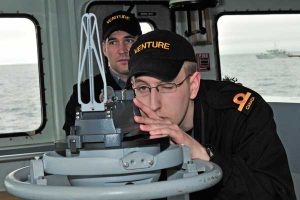Last practice run for MARS students
By Lookout on Mar 11, 2013 with Comments 1

A/SLt Malcolm Gardiner, officer of the watch, is in charge of the safe movement of the ship. He fixes on a point to get a bearing on the pelorus.
Two weeks ago, officer of the watch A/SLt Matthew Noiles stood on the bridge of Patrol Training Craft Caribou 57, his eye level with the pelorus.
“Recommend come left 20 degrees new course one zero zero at stationing speed,” he said to the Captain, LCdr Sam Patchell.
LCdr Patchell assessed the speed and course recommended and responded, “Yes please.”
The Orca class vessel then veered left in sync with the other five Orcas in the formation sailing off Esquimalt Harbour.
This manoeuvre was part of a training exercise on Feb. 28 for junior officers, which involved the entire fleet of Patrol Craft Training vessels.
For the junior officers it was a stressful time, as it tested the navigation and seamanship in the final stages of their Maritime Surface and Subsurface (MARS) training.
If they misunderstood a signal and turned the wrong way they could easily have a collision between two ships.
“Manoeuvring is about being a team within the ship,” says the course training officer, Lt(N) Travis Bain. “They need to use time-management skills, multitasking and have good direction to support the team. There is a lot happening at once.”
Students have learned ship handling in the classroom and in the simulator, so during the exercise they had to receive signals and get the ship in formation safely while giving direction to the team and briefing the Captain.
On board PTC Caribou, five MARS IV students were in the final stages of this intense sea phase training. Each rotated to different positions on the bridge and throughout the day took bearings to advise the captain on navigation.
It has taken these students nearly two years of intense training at the Naval Officer Training Centre (NOTC) Venture to get to this stage.
“When they join the Fleet they can expect to do manoeuvres like this,” says LCdr Patchell. “This training gives them a controlled environment at sea to practice in.”
On March 23, MARS students will graduate and move into bigger hulls when they join the Fleet on either East or West coast as bridge watch keepers.
Q&A with MARS students
A/SLt Matthew Noiles (26 years old)
-What attracted you to the MARS trade versus engineering or logistics?
I was attracted to the MARS trade because I didn’t want to be behind a desk.
-What challenges did you face along the way in MARS training?
It’s been challenge after challenge. Academically there have been many tests and I just keep hoping to make it to the next one. At sea we are given constant practical challenges like manoeuvring, navigation, and applying all of the skills as officer of the watch. The officer of the watch is working with his range officer and velocity officer to manoeuvre the ship correctly. There is a lot happening and we are using all the skills we have learned.
-In a few weeks from now when you join the Fleet as bridge watch keeper, what will it feel like to achieve this goal?
I’m anxious and nervous and excited at the same time. The bridge watch keeper is responsible for the safety of the ship, and leading the ship and company through operations and safe movements. I think in this role you’re always a little nervous as there is so much going on and a lot of pressure.
A/SLt Kent McLeod (28 years old)
-What did you do before you joined the navy and how does it relate to what you are doing now?
I was a forester before joining the navy, but I was also a cadet previously. Being a cadet gave me an insight into the MARS trade. I knew it would be a challenging job and one that I wanted to take on.
-What attracts you to the East or West coast?
I was born and raised in Chemainus so I am hoping to be posted to a ship in the west coast fleet.
-What did you enjoy most and least about the MARS training?
I really enjoyed watch on deck and being able to finally interact with the crew. It was a lot better than the simulator at Naval Officer Training Centre (NOTC) Venture because we can interact with other people, aside from the junior officers. What I enjoyed the least would be the pressure and stress put on us throughout the course. We were given tasks that are difficult to the point that you must work as a team to achieve them. This is both frustrating and difficult. It’s a vertical learning curve. You have to learn a lot quickly and retain it. They tell you once and you should not have to be told again.
-In a few weeks from now when you join the Fleet as bridge watch keeper, what will it feel like to achieve this goal?
It is going to be interesting going from a training facility with peers where everyone is in the same boat, so to speak, to a situation where it’s not about me and my training anymore. It’s about sailing a ship and that’s something you don’t want to screw up. The Orcas give you an opportunity to practice, but you don’t know if you’ve got what is required until you actually get there. It will feel good to finally accomplish what we have worked so hard at for the past couple of years.
-Shelley Lipke, Staff Writer
Filed Under: Top Stories
About the Author:






Nice!